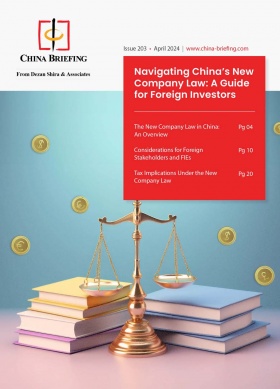China Announces Industrial Equipment Upgrading Action Plan
China announced an ambitious action plan for industrial equipment upgrading, which aims to drive technological innovation and economic growth through extensive investment and regulatory support.
On April 9, 2024, China’s Ministry of Industry and Information Technology (MIIT) and six other departments jointly released a notice introducing the Implementation Plan for Promoting Equipment Renewal in the Industrial Sector (hereafter referred to as the “action plan”).
Finalized earlier on March 23, 2024, this comprehensive action plan addresses critical issues related to technological innovation and economic development. It reflects China’s proactive stance in enhancing competitiveness and sustainability within its manufacturing sector. The initiative underscores the recognition of industrial equipment upgrading as a top policy priority.
In this article, we delve into the specifics of China’s industrial equipment upgrade initiative, exploring its objectives, scope, key components, challenges, and future expectations in detail.
China’s industrial equipment upgrading action plan: Overview
The scope of China’s action plan to upgrade industrial equipment in manufacturing, is extensive, covering various aspects such as:
- Replacement of outdated equipment, particularly machine tools that have been in use for over a decade;
- Upgrading equipment in key sectors like aerospace, solar energy, and battery manufacturing;
- Integration of industrial robots and the industrial internet; and
- Adoption of green technology to promote environmental sustainability.
Key objectives
In line with China’s ambitious goals for industrial modernization and sustainable development, the action plan outlines several key objectives aimed at driving substantial advancements in the industrial sector by 2027.
These objectives encompass a wide range of areas, from increasing investment to enhancing digitalization and promoting innovation, including:
- Investment growth: The action plan aims to significantly boost investment in the industrial sector by over 25 percent compared to 2023.
- Digital transformation: A crucial aspect of the action plan involves the widespread adoption of digital research, development, and design tools in large-scale industrial enterprises. By achieving a penetration rate of over 90 percent for these tools, China seeks to streamline processes, enhance efficiency, and stay at the forefront of digital innovation.
- Numerical Control (NC) technology: According to the action plan, with a targeted NC rate exceeding 75 percent, industries can improve precision, optimize workflows, and elevate production standards.
- Nationwide digitization: To ensure comprehensive modernization, the action plan aims for full coverage of digitization across industrial provinces, cities, and key parks.
- Enhanced energy efficiency and safety: Improving energy efficiency and safety standards is paramount for sustainable development. The plan seeks to phase out outdated production capacity, achieve basic energy-saving levels for major equipment, and elevate safety standards across industries.
The objectives and key actions proposed in the action plan are summarized below.
|
Key Objectives and Actions Proposed in the Action Plan |
|
| Objectives | Actions |
| Accelerate equipment renewal and modernization across industries |
|
| Promote the adoption of smart manufacturing equipment |
|
| Expand the application of intelligent manufacturing equipment |
|
| Accelerate the green transformation of production equipment |
|
| Upgrade the energy efficiency of key energy-consuming equipment |
|
| Accelerate the application of solid waste treatment and water-saving equipment |
|
| Improve the intrinsic safety level of industrial equipment |
|
| Enhance the intrinsic safety level of the civil explosives industry |
|
| Promote the application of advanced and suitable safety equipment |
|
Support measures
In facilitating technological advancement across industries, the action plan outlines several key support measures aimed at bolstering financial, regulatory, and resource-related aspects to create an enabling environment for enterprises to embrace innovation and upgrade their equipment and technologies. These are:
- Fiscal and taxation support: This includes allocating funds from the central budget to finance essential equipment renewal and technological transformation projects in industries. Additionally, the action plan proposes enhanced tax incentives for specialized equipment promoting energy and water conservation, environmental protection, and production safety. It also extends these incentives to cover digitalization and intelligent transformation initiatives, incentivizing enterprises to adopt cutting-edge technologies.
- Strengthened guidance: These standards focus on energy conservation, carbon reduction, environmental protection, safety, and recycling, tailored to specific industries and key areas. By implementing industrial energy conservation and green standardization actions, the plan aims to create a conducive regulatory framework encouraging enterprises to align their equipment updates and technological transformations with advanced standards.
- Financial support: The action plan proposes establishing special re-loans dedicated to technological innovation and transformation. Financial institutions are encouraged to bolster their support for equipment renewal and technological transformation projects.
- Local governments support: Local governments are encouraged to prioritize protecting essential resources required for enterprise projects, including land use and energy consumption.
Why is China promoting industrial equipment upgrading?
The action plan aligns with the broader vision of the Chinese government to promote large-scale equipment renewal and consumer goods trade-ins, unlocking a vast market worth trillions of yuan. As reiterated in the action plan, China aims to increase investment in equipment upgrades across sectors like industry and agriculture by 25 percent in 2027.
This initiative targets energy efficiency, emissions reduction, and the facilitation of digital transformation and smart enhancements in key industries.
Last year, China allocated approximately RMB4.9 trillion (approx. US$682 billion) to new equipment in critical sectors. According to the Bank of China Research Institute, these upgrades are expected to significantly boost China’s fixed asset investment, driving overall economic growth by about 0.4 percent.
During a press conference, Zheng Shanjie, chairman of the National Development and Reform Commission (NDRC), highlighted that with the ongoing emphasis on high-quality development, demand for new equipment is projected to rise, aiming for an annual spending target of at least RMB5 trillion (approx. US$695.3 billion) by 2027.
As part of the plan, consumers will be incentivized to exchange their old goods, with significant increases expected in the recycling of scrapped vehicles, used car transactions, and recycled home appliances within this time frame. As noted by Zheng, with China’s civilian-use cars numbering 336 million and home appliances exceeding 3 billion by the end of last year, the replacement of old goods could potentially reach RMB1 trillion (US$138.1 billion).
How to read the action plan?
The action plan outlines China’s significant effort to upgrade industrial equipment in the manufacturing sector, reflecting its recent focus on this area. Policymakers are hopeful that this initiative will drive technological advancement and fuel economic growth. Although the plan offers substantial incentives and lending programs to support equipment purchases and upgrades, it also presents challenges.
Specifically, the requirement for compliance with updated safety and carbon emissions standards may necessitate unexpected upgrades for some companies.
For foreign manufacturers, this initiative is noteworthy, with further details on policy incentives anticipated in the coming months.
Looking ahead, while the action plan is expected to boost short-term industrial investment, its effectiveness depends on ensuring that investments are channeled into appropriate upgrades.
About Us
China Briefing is one of five regional Asia Briefing publications, supported by Dezan Shira & Associates. For a complimentary subscription to China Briefing’s content products, please click here.
Dezan Shira & Associates assists foreign investors into China and has done so since 1992 through offices in Beijing, Tianjin, Dalian, Qingdao, Shanghai, Hangzhou, Ningbo, Suzhou, Guangzhou, Dongguan, Haikou, Zhongshan, Shenzhen, and Hong Kong. We also have offices in Vietnam, Indonesia, Singapore, United States, Germany, Italy, India, and Dubai (UAE) and partner firms assisting foreign investors in The Philippines, Malaysia, Thailand, Bangladesh, and Australia. For assistance in China, please contact the firm at china@dezshira.com or visit our website at www.dezshira.com.
- Previous Article China to Relax Foreign Ownership Limits in Value-Added Telecommunication Services
- Next Article How to Get a Certificate of No Criminal Record in China – A Guide for Foreign Residents









